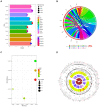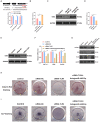SARS-CoV-2-induced Overexpression of miR-4485 Suppresses Osteogenic Differentiation and Impairs Fracture Healing
- PMID: 33867845
- PMCID: PMC8040480
- DOI: 10.7150/ijbs.56657
SARS-CoV-2-induced Overexpression of miR-4485 Suppresses Osteogenic Differentiation and Impairs Fracture Healing
Abstract
The angiotensin-converting enzyme 2 (ACE2) receptor has been identified as the cell entry point for SARS-CoV-2. Although ACE2 receptors are present in the bone marrow, the effects of SARS-CoV-2 on the biological activity of bone tissue have not yet been elucidated. In the present study we sought to investigate the impact of SARS-CoV-2 on osteoblastic activity in the context of fracture healing. MicroRNA-4485 (miR-4485), which we found to be upregulated in COVID-19 patients, negatively regulates osteogenic differentiation. We demonstrate this effect both in vitro and in vivo. Moreover, we identified the toll-like receptor 4 (TLR-4) as the potential target gene of miR-4485, and showed that reduction of TLR-4 induced by miR-4485 suppresses osteoblastic differentiation in vitro. Taken together, our findings highlight that up-regulation of miR-4485 is responsible for the suppression of osteogenic differentiation in COVID-19 patients, and TLR-4 is the potential target through which miR-4485 acts, providing a promising target for pro-fracture-healing and anti-osteoporosis therapy in COVID-19 patients.
Keywords: Differentiation; Fracture; Osteoblast; SARS-CoV-2; miR-4485.
© The author(s).
Conflict of interest statement
Competing Interests: The authors have declared that no competing interest exists.
Figures







Similar articles
-
MiR-140-5p promotes osteogenic differentiation of mouse embryonic bone marrow mesenchymal stem cells and post-fracture healing of mice.Cell Biochem Funct. 2020 Dec;38(8):1152-1160. doi: 10.1002/cbf.3585. Epub 2020 Oct 12. Cell Biochem Funct. 2020. PMID: 33047358 Free PMC article.
-
Effects of SARS-CoV-2 on Cardiovascular System: The Dual Role of Angiotensin-Converting Enzyme 2 (ACE2) as the Virus Receptor and Homeostasis Regulator-Review.Int J Mol Sci. 2021 Apr 26;22(9):4526. doi: 10.3390/ijms22094526. Int J Mol Sci. 2021. PMID: 33926110 Free PMC article. Review.
-
A new insight into sex-specific non-coding RNAs and networks in response to SARS-CoV-2.Infect Genet Evol. 2022 Jan;97:105195. doi: 10.1016/j.meegid.2021.105195. Epub 2021 Dec 23. Infect Genet Evol. 2022. PMID: 34954105 Free PMC article.
-
Alteration of L-Dopa decarboxylase expression in SARS-CoV-2 infection and its association with the interferon-inducible ACE2 isoform.PLoS One. 2021 Jun 29;16(6):e0253458. doi: 10.1371/journal.pone.0253458. eCollection 2021. PLoS One. 2021. PMID: 34185793 Free PMC article.
-
Multifunctional angiotensin converting enzyme 2, the SARS-CoV-2 entry receptor, and critical appraisal of its role in acute lung injury.Biomed Pharmacother. 2021 Apr;136:111193. doi: 10.1016/j.biopha.2020.111193. Epub 2021 Jan 5. Biomed Pharmacother. 2021. PMID: 33461019 Free PMC article. Review.
Cited by
-
Micro-Epigenetic Markers in Viral Genome: SARS-CoV-2 Infection Impact on Host Cell MicroRNA Landscape.Maedica (Bucur). 2024 Dec;19(4):842-847. doi: 10.26574/maedica.2024.19.4.842. Maedica (Bucur). 2024. PMID: 39974441 Free PMC article.
-
COVID-19 Pandemic and Osteoporosis in Elderly Patients.Aging Dis. 2022 Jul 11;13(4):960-969. doi: 10.14336/AD.2021.1201. eCollection 2022 Jul 11. Aging Dis. 2022. PMID: 35855327 Free PMC article.
-
Lag analysis of the effect of air pollution on orthopedic postoperative infection in Hebei Province and Xinjiang Uygur Autonomous Region.Sci Rep. 2025 Apr 15;15(1):12919. doi: 10.1038/s41598-025-95550-5. Sci Rep. 2025. PMID: 40234548 Free PMC article.
-
Shared miRNA landscapes of COVID-19 and neurodegeneration confirm neuroinflammation as an important overlapping feature.Front Mol Neurosci. 2023 Mar 17;16:1123955. doi: 10.3389/fnmol.2023.1123955. eCollection 2023. Front Mol Neurosci. 2023. PMID: 37008787 Free PMC article.
-
Cellular miR-150-5p may have a crucial role to play in the biology of SARS-CoV-2 infection by regulating nsp10 gene.RNA Biol. 2022;19(1):1-11. doi: 10.1080/15476286.2021.2010959. Epub 2021 Dec 31. RNA Biol. 2022. PMID: 34904915 Free PMC article.
References
-
- Rader B, Scarpino SV, Nande A, Crowding and the shape of COVID-19 epidemics. Nat Med. 2020. undefined. doi: 10.1038/s41591-020-1104-0. - PubMed
MeSH terms
Substances
LinkOut - more resources
Full Text Sources
Other Literature Sources
Medical
Miscellaneous

